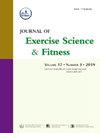Association between sedentary behavior, physical activity, and the triglyceride glucose index and its derived indices: evidence from NHANES 2013–2018
IF 2.4
2区 医学
Q2 SPORT SCIENCES
引用次数: 0
Abstract
Background
While sedentary behavior and physical activity have been associated with the TyG index, their associations with TyG-derived indices and their potential interaction remain unclear.
Objective
This study aimed to examine the independent and interactive associations of sedentary behavior and physical activity with the TyG index and its derived indices.
Methods
This cross-sectional analysis used NHANES 2013–2018 data. We employed survey-weighted multivariate regression and restricted cubic splines to evaluate independent and nonlinear associations. Multiplicative interaction terms were used to examine if physical activity levels altered the association between sedentary behavior and outcomes.
Results
After multivariable adjustment, longer sedentary time was significantly associated with higher TyG index (β = 0.0051, p < 0.0001), TyG-BMI (β = 1.1395, p < 0.0001), TyG-WHtR (β = 0.0163, p < 0.0001) and TyG-WC (β = 3.0860, p < 0.0001). Higher physical activity showed inverse associations with TyG (β = −0.0039, p < 0.0001), TyG-BMI (β = −0.2677, p = 0.0007), TyG-WHtR (β = −0.0054, p < 0.0001) and TyG-WC (β = −1.0057, p < 0.0001). Nonlinear relationships were observed between physical activity and TyG-BMI, TyG-WHtR, and TyG-WC (p < 0.01). Significant interactions existed between sedentary behavior and physical activity on TyG (p = 0.037), TyG-WHtR (p = 0.047) and TyG-WC (p = 0.047).
Conclusion
Prolonged sedentary behavior and lower physical activity showed associations with adverse profiles of the TyG index and its derivatives. Significant interactions between these behaviors were observed, indicating a particularly important combined association with central obesity-related indices. Integrating reductions in sedentary time with increases in physical activity could represent a synergistic approach for improving metabolic health.
久坐行为、身体活动与甘油三酯葡萄糖指数及其衍生指数之间的关联:来自NHANES 2013-2018的证据
虽然久坐行为和体育活动与TyG指数有关,但它们与TyG衍生指数的关系及其潜在的相互作用尚不清楚。目的探讨久坐行为和体力活动与TyG指数及其衍生指数之间的独立和互动关系。方法采用NHANES 2013-2018数据进行横断面分析。我们采用调查加权多元回归和限制三次样条来评估独立的和非线性的关联。乘法交互项被用来检验身体活动水平是否改变了久坐行为和结果之间的联系。结果经多变量调整后,久坐时间较长与TyG指数(β = 0.0051, p < 0.0001)、TyG- bmi (β = 1.1395, p < 0.0001)、TyG- whtr (β = 0.0163, p < 0.0001)、TyG- wc (β = 3.0860, p < 0.0001)升高显著相关。高体力活动与TyG (β = - 0.0039, p < 0.0001)、TyG- bmi (β = - 0.2677, p = 0.0007)、TyG- whtr (β = - 0.0054, p < 0.0001)和TyG- wc (β = - 1.0057, p < 0.0001)呈负相关。体力活动与TyG-BMI、TyG-WHtR、TyG-WC呈非线性关系(p < 0.01)。久坐行为与身体活动在TyG (p = 0.037)、TyG- whtr (p = 0.047)和TyG- wc (p = 0.047)上存在显著交互作用。结论久坐行为和低体力活动与TyG指数及其衍生物的不良特征有关。观察到这些行为之间的显著相互作用,表明与中心肥胖相关指数特别重要的联合关联。将减少久坐时间与增加体力活动结合起来,可能是改善代谢健康的一种协同方法。
本文章由计算机程序翻译,如有差异,请以英文原文为准。
求助全文
约1分钟内获得全文
求助全文
来源期刊
CiteScore
5.10
自引率
3.60%
发文量
54
审稿时长
31 days
期刊介绍:
The Journal of Exercise Science and Fitness is the official peer-reviewed journal of The Society of Chinese Scholars on Exercise Physiology and Fitness (SCSEPF), the Physical Fitness Association of Hong Kong, China (HKPFA), and the Hong Kong Association of Sports Medicine and Sports Science (HKASMSS). It is published twice a year, in June and December, by Elsevier.
The Journal accepts original investigations, comprehensive reviews, case studies and short communications on current topics in exercise science, physical fitness and physical education.

 求助内容:
求助内容: 应助结果提醒方式:
应助结果提醒方式:


